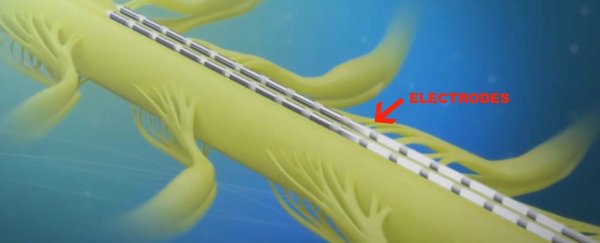Doctors in the US have developed a stimulator that bypasses spinal injuries by forcing the body to use alternative pathways to transmit signals from the brain to other areas of the body.
In the latest test, the team has shown that the device can improve a quadriplegic patient's finger motion by 300 percent while improving grip strength, helping him to perform everyday tasks again.
Back in June, the team from the Ronald Reagan University of California, Los Angeles Medical Centre performed surgery to implant the newly developed device inside a 28-year-old California man named Brian Gomez.
During a dirt biking accident five years ago, Gomez broke his neck at his C-5 vertebra - the vertebra at the middle of the neck near the thyroid cartilage - causing him to lose function in all of his extremities.
"Even though he was injured in 2011, in many ways [Gomez] is a perfect candidate for this experimental treatment," said team member Daniel Lu.
"He still has head-to-toe sensation, so he can give us feedback as we fine-tune the stimulator. And he is such a positive and motivated young man."
The device, which is a series of 32 electrodes that can send pulses around the injured area, was implanted into Gomez's neck where his C-5 vertebra was injured.
According to the team, this allows the brain to continue to send messages to the rest of the body by bypassing the injured pathways.
"The spinal cord contains alternate pathways that it can use to bypass the injury and get messages from the brain to the limbs. Electrical stimulation trains the spinal cord to find and use these pathways," Lu said.
"If there is an accident on the freeway, traffic comes to a standstill, but there are any number of side streets you can use to detour the accident and get where you are going. It's the same with the spinal cord."
Alongside these stimulating electrodes, the team has also implanted a battery pack that can be fine-tuned into certain patterns, providing more or less stimulation to certain areas where needed.
The basic idea here is that the electrodes continue to pulse into the region, stimulating pathways that the brain might be ignoring.
Over time, these pathways open up and allow messages from the brain to pass through them. In a way, it's like retraining the body to use these undamaged 'side streets', Lu says, to bring functionality back to the extremities.
In previous studies, the team used a similar device on two paraplegic patients with lumbar injuries - ones occurring lower in the spine - but it was noninvasive.
The device Gomez is currently using is the first time that the doctors have tried their electrode technology on someone suffering from quadriplegia stemming from a neck injury, and also have it implanted under the skin.
"We'd used electrical stimulation to recover paraplegic patients' abilities to stand and move their legs on their own following injury to the lower spine," explains team member Reggie Edgerton.
"There was considerable scepticism in the field that we could use a similar approach to regain hand function in quadriplegic patients with injury to the upper spine. [Gomez]'s strong response to the implant has been very exciting."
That "strong response" is seen in Gomez's ability to now utilise his hands for everyday tasks such as working at his coffee roasting company. As he recounts:
"It's making a huge difference for me. I use an industrial roaster that heats up to 450 degrees Fahrenheit [232 degrees Celsius] and just a few months ago, I reached up to pull a lever to empty a batch of beans after they'd finished roasting.
But because I didn't have the arm or core strength, I burned myself. That doesn't happen anymore because of the strength and dexterity I've developed."
Gomez's remarkable improvements are all the more impressive because his injury happened so long ago. The team says that spinal injuries like his usually have a window of time for treatment before they are irreversible.
Their goal isn't to bring back 100 percent function, though. It's mainly to allow patients to perform daily tasks that were impossible before. This includes many things that we take for granted, such as brushing our teeth, tying our shoes, or simply eating food with a fork.
"A normal hand is able to impart about 100 to 200 newtons of force, but after an accident, that often drops to only 1 or 2 newtons of force," Lu says.
"Our goal is to get these patients back to the 20 to 30 range. That will allow them to do everyday tasks and will make a huge difference in the quality of their lives."
So far, the device has only been tested on one patient, so we can't get too excited. The next step is for the team to have the results peer-reviewed and published in a journal once they have more data.
In the meantime, check out the video below to hear more about the treatment:
